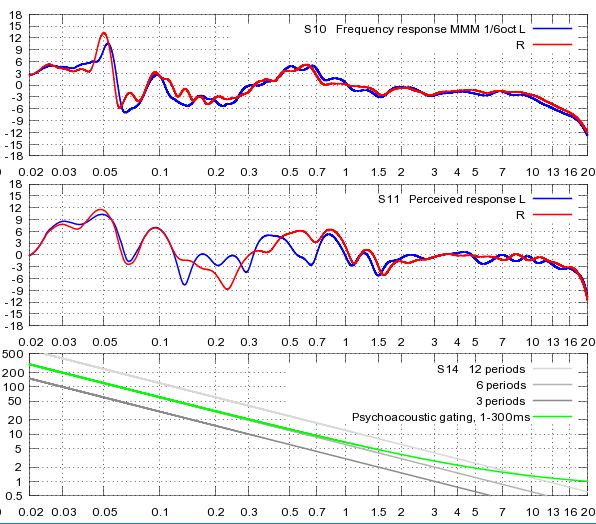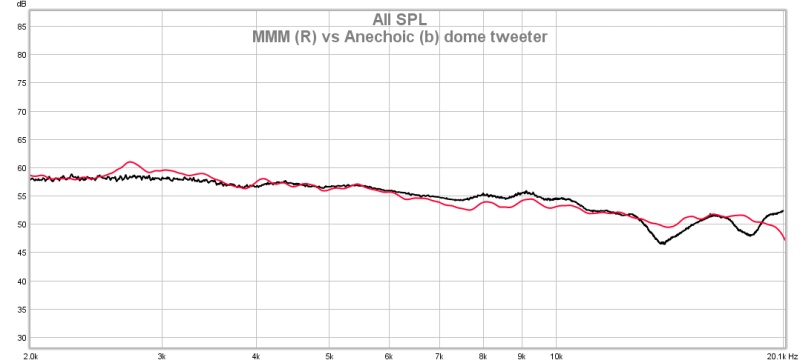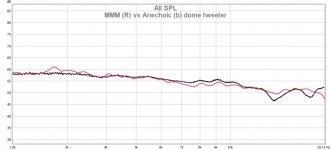I got both 0 and 90 deg calibration files for my more than two years old UMIK-1. Go to minidsp homepage ->UMIK page and download cal files again (give mic's serial number). The difference is obviously at highest frequency range.
90¤ cal should suit this better than axial. However the difference is minimal. MMM measurements always rapidly tilt down above 10kHz, that is normal.
90¤ cal should suit this better than axial. However the difference is minimal. MMM measurements always rapidly tilt down above 10kHz, that is normal.
One must keep in mind that power response is not what we want. That's because the ear processes signals faster at higher frequencies and as such a long time average is not accurate to our hearing perception. A sliding window is the better way to do this. I am not sure how well a sliding window will work with a continuously moving mic. Probably fine if the sweep rate is very slow.
Thanks Juhazi. I do remember seeing a 90 degree cal file on the website.
I don't understand the term "sliding window". Would you care to clarify? Thanks
One must keep in mind that power response is not what we want. That's because the ear processes signals faster at higher frequencies and as such a long time average is not accurate to our hearing perception. A sliding window is the better way to do this. I am not sure how well a sliding window will work with a continuously moving mic. Probably fine if the sweep rate is very slow.
I don't understand the term "sliding window". Would you care to clarify? Thanks
I suppose that Earl is speaking about an analysis window which time length depends on frequency. You can see such one in the third graph hereunder, green curve. Length is about 1ms on highest frequencies and 300ms on lowest.I don't understand the term "sliding window". Would you care to clarify?
You're right but what's MMM ? A localized power response ?(who first used this terminology ?)One must keep in mind that power response is not what we want
As an example, here is a comparison between MMM measurement and a sliding window measurement (here call perceived response). I prefer to use MMM as a basis for correction because it allways gives me less "artefacts" than any windowed measurement.

JLO is correct about how the sliding window works, but I disagree that one should use the method that "always gives me less "artefacts"". Its those "artifacts" that we hear and need to be corrected.
When I mean "artefacts", I should explain :
when you compare many measurements at about 1 feet one from another, you get different responses if you use a long window... but also when you use a sliding window.
Despite the fact that perceived timbral quality is the same at those listening points.
So for me, any kind of measurement that does not give same curves when perception is similar, is not valid for correction.
The idea behind MMM was to find a measurement strategy that comes as close as possible of true perception. After having measured lots of studios, mixing rooms and amateur systems, having compared various methods, MMM is the method I prefer for now.
when you compare many measurements at about 1 feet one from another, you get different responses if you use a long window... but also when you use a sliding window.
Despite the fact that perceived timbral quality is the same at those listening points.
So for me, any kind of measurement that does not give same curves when perception is similar, is not valid for correction.
The idea behind MMM was to find a measurement strategy that comes as close as possible of true perception. After having measured lots of studios, mixing rooms and amateur systems, having compared various methods, MMM is the method I prefer for now.
Last edited:
This is precisely why speakers should not be EQ'd above Fs using room data. They should be EQ'd anechoic and the room corrected only in the modal region. However, this would not be much different than EQing to a spatial average of a sliding window. To EQ based on a spatial average of a long time window is the same as EQing the power response. Better than nothing, but not as good as having a flat direct response (which a sliding window approximates.) And if the speakers are CD and EQ'd anechoic, then the in room power response is going to be flat (or slightly falling as desired) above Fs anyways.
(who first used this terminology ?)
I hope that you realize that it was actually myself who first used this terminology in my AES paper "Equalized Sound Power". But that was more than 30 years ago and things have progressed from there. I personally don't use that technique anymore, although, at the time, it was quite an advancement in audio technology.
You EQ to your liking when playing sources cooked by the producers of that genre the way you like at a level of loudness you typically use. Flat is an interesting data line but not the goal of EQ'ing your music room.
Call it artefacts or reality, makes no sense to adjust minor irregularities, as Earl says, but sometimes you do want to address level across and octave or two to your taste, as well as room modes lower down.
So a lot fuss over differences in time-windows and mic location seem too minor to worry about, as jol's nice charts show.
In light of the many challenges to collecting actionable and stable acoustic data, it is best to make a jig to locate your mic in the same precise location each time and go from there. At least your measurements will be repeatable and stable and you can observe even small adjustments to your EQ or driver loudness step by step.... which is just what you want.
And you can't get that kind of stability waving the mic in the air, even if your findings are more representative of the room as a whole, in some abstract sense.
Ben
Call it artefacts or reality, makes no sense to adjust minor irregularities, as Earl says, but sometimes you do want to address level across and octave or two to your taste, as well as room modes lower down.
So a lot fuss over differences in time-windows and mic location seem too minor to worry about, as jol's nice charts show.
In light of the many challenges to collecting actionable and stable acoustic data, it is best to make a jig to locate your mic in the same precise location each time and go from there. At least your measurements will be repeatable and stable and you can observe even small adjustments to your EQ or driver loudness step by step.... which is just what you want.
And you can't get that kind of stability waving the mic in the air, even if your findings are more representative of the room as a whole, in some abstract sense.
Ben
Last edited:
Ben
I prefer to have the sound be what the producer intended, or as close as possible to that. Hence, what I "prefer" is then not relevant. I have a "reference" system, not a "preference" system. I have become quite intolerant of "preference" based systems.
I don't think that you quite understand about taking measurements at fixed points and what the sampling statistics are. At a fixed point you would not likely get a precise match from day to day simply because of temperature changes, humidity, etc. The precise modal additions are extremely sensitive to small changes in the environment, but don't mean anything when we listen (see my book for an example of this.) One needs to do "some" averaging to get beyond this problem if one is going to do in-situ work.
I prefer to have the sound be what the producer intended, or as close as possible to that. Hence, what I "prefer" is then not relevant. I have a "reference" system, not a "preference" system. I have become quite intolerant of "preference" based systems.
I don't think that you quite understand about taking measurements at fixed points and what the sampling statistics are. At a fixed point you would not likely get a precise match from day to day simply because of temperature changes, humidity, etc. The precise modal additions are extremely sensitive to small changes in the environment, but don't mean anything when we listen (see my book for an example of this.) One needs to do "some" averaging to get beyond this problem if one is going to do in-situ work.
😀 That's a good description of the MMM.loving this tai chi method.
Earl -Ben
I prefer to have the sound be what the producer intended, or as close as possible to that. Hence, what I "prefer" is then not relevant. I have a "reference" system, not a "preference" system. I have become quite intolerant of "preference" based systems.
I don't think that you quite understand about taking measurements at fixed points and what the sampling statistics are. At a fixed point you would not likely get a precise match from day to day simply because of temperature changes, humidity, etc. The precise modal additions are extremely sensitive to small changes in the environment, but don't mean anything when we listen (see my book for an example of this.) One needs to do "some" averaging to get beyond this problem if one is going to do in-situ work.
I don't think you quite understand a few things.
First, I don't know what the producer had in mind. Do you? This is roughly as much true of purist classical music recordings where people have a fantasy about hearing sound like in a hall - something which can't be defined let alone reproduced in my little room at home.
Do the people making recordings of female pop or jazz singers all want them to sound unnaturally breathy? If so, and if you like that treble boost, you should EQ in order to hear it that way at home. It is clearly unnatural and it clearly is what the producer wanted and you want to hear like the producer wanted.
Or possibly the producers intended Diana Krall to sound just a bit breathy on my car radio with 60dB of background noise. In which case, when listening at home, you need to turn down the treble so that is sounds like the producer wanted in your car. That what your said you want, right? Either way, no way to know except by taste (unless the producer sent you a tweet about how they wanted it to sound).
All I know is the sound I get: is it to my taste or can be made so.
The examples you gave are no more than rhetorical points. The influence of humidity and temperature is less than moving your mic a few inches and for all I know may be of no consequence at all depending on your HVAC.
You talk about stats and averaging. What is more important in good testing is getting your standard deviation of measurements low and having good "lab technique". Then you can average.
Again, if you want actionable information, better to start on solid ground. After making whatever exploratory further tests, you then know how to make allowances.
Ben
Last edited:
Ben, saying recorded issues are greater than speaker/room issues isn't a reason to ignore them IMO. I'm OK with some song dependent EQ but getting the speaker/room right first is important. You can tell yourself it will all wash out if you can just find the right EQ by ear each time, but I find this attitude to lead to tedious listening and the chance that something is 'never right'.
All well put. But my point is good "lab technique" is not waving a mic around in the air, whether you believe in ad hoc EQ, like flat sound at your chair, "house curve" for typical music and loudness (which I favour), or whatever. But the moving mic and other methods (like near field or back yard testing) can add actionable information like helping distinguish speaker performance from room modes.Ben, saying recorded issues are greater than speaker/room issues isn't a reason to ignore them IMO. I'm OK with some song dependent EQ but getting the speaker/room right first is important
Since my music room has only one listening chair, I couldn't care less about the sound elsewhere in the room. That may be true of a lot of people here. I also care about a lot of acoustic qualities of which FR is just one (and sometimes obscures the others).
B.
Last edited:
Ben, I don't know where to start. If someone were to lead you into a strange room/enclosure/shed wearing a blindfold, would you not sense the ambience?Since my music room has only one listening chair, I couldn't care less about the sound elsewhere in the room.
Yes. Not only that, I might sense the FR, RT, distortion, source localization, and if they had a BR box or TH, the "group delay" boom. All if not in any absolute or confident sense, at least relatively.Ben, I don't know where to start. If someone were to lead you into a strange room/enclosure/shed wearing a blindfold, would you not sense the ambience?
I wouldn't hear the comb filtering, nor would anybody.
What point are you making? How does that relate to method of testing FR?
B.
Last edited:
I've had listening rooms like that. Funny thing is, the "listening" was not normally done by a tiny, omnidirectional mic element at a fixed point in space. The listening was generally done by me, a human with two ears on either side of a fat head, a head that moves. Not a lot like a single point in space.Since my music room has only one listening chair, I couldn't care less about the sound elsewhere in the room.
Averaging the measurements is important if you want good results. When I used to do THX and Dolby cinema alignments, averaging was mandatory, as you can well imagine. At home we don't have to average over such a large area, but an area right around the listening position does help.
When I used the MMM the results were very repeatable and reliable over the small area where I used it. Is it better or more useful than a multi point averaged measurement using a sliding window? I don't know because I've not done direct comparisons. But I do know that using the MMM resulted in more consistent measurements and a better subjective tonal balance than most methods I've tried, averaged or not.
at high frequencies, mmm is the closest thing I know to mimicing the actual anechoic speaker response.
here is the anechoic response of a tweeter vs the mmm at the mlp - no smoothing or windowing for either measurement

btw, still using mmm from sub frequencies to 20khz and still loving it. although I dont eq above 10khz
here is the anechoic response of a tweeter vs the mmm at the mlp - no smoothing or windowing for either measurement
btw, still using mmm from sub frequencies to 20khz and still loving it. although I dont eq above 10khz
Attachments
Last edited:
I believe you are imprecise in saying no smoothing or windowing.here is the anechoic response of a tweeter vs the mmm at the mlp - no smoothing or windowing for either measurement
Here's a meaningful test reflecting MMM stability (but not accuracy):
1. run MMM
2. raise volume 2 dB and run again (exact increment doesn't matter much)
3. Post superimposed results
I doubt anybody thinks the MMM method isn't helpful. It is a convenient means of taking a soft-focus snapshot of the sound in the listening area. Soft-focus pictures make 60 year old fashion models selling face creams look great.
My criticism of it is that it is too unstable (or unwieldy if you take the time or do enough passes to average well) for the sort of iterative (and re-iterative and re-re-iterative) adjustments to follow the measurements.
B.
Last edited:
I believe you are imprecise in saying no smoothing or windowing.
My criticism of it is that it is too unstable (or unwieldy if you take the time or do enough passes to average well) for the sort of iterative (and re-iterative and re-re-iterative) adjustments to follow the measurements.
B.
I believe you have no idea what you are talking about
- Home
- Loudspeakers
- Multi-Way
- Moving Mic Measurement
